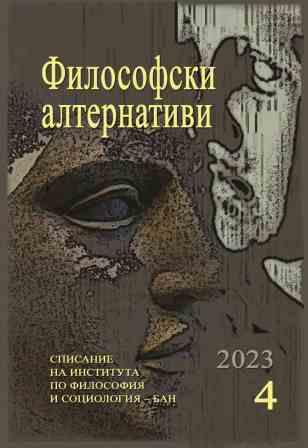The Cosmos as the Hierarchy of Self-Similarity of the One: Plato’s Doctrine of the Beautiful in the Light of the Theory of Fractals
The Cosmos as the Hierarchy of Self-Similarity of the One: Plato’s Doctrine of the Beautiful in the Light of the Theory of Fractals
Author(s): Nadezhda ZudilinaSubject(s): Philosophy, Metaphysics, Aesthetics, Special Branches of Philosophy, Philosophy of Science
Published by: Институт по философия и социология при БАН
Keywords: the One; self-similarity; beauty; diaeresis; fractal; Plato; image; εἶδος (eidos); εἰκών (eikon); εἴδωλον (eidolon); the same; the other; the similar; intensiveness axis; extensiveness axis
Summary/Abstract: The introduction of the intensiveness (depth) axis, orthogonal to the extensiveness (length–width–height) axis makes it possible to consider the beautiful Cosmos as the hierarchy of resemblances of the One, on the basis of the diaeresis of line proposed by Plato in the dialogue The Republic. Each line segment obtained as a result of diaeresis is designated by one (1), zero (0) or a numerical combination consisting of ones and zeros. One (1) is assigned the value “intensiveness”, and zero (0) is assigned the value “extensiveness”. Through the application of the intensiveness and extensiveness axes, the interpretation of the segments on each of the levels of the diaeresis of line along the intensiveness axis is given. The One (1=⟂) on zero level of diaeresis is beyond the dialectical opposites, but nevertheless beautiful Νοῦς (Nous, the Cosmic Mind) is Its likeness. On the first level of the diaeresis, both the intensive (1, or point), as the representation of the mental (Nous), and the extensive (0, or line), as the representation of the material, are derived from the One (1=⟂). Nous is purely intensive. The intensive is the same (τὸ ταὐτόν). The mixture of the same and the other (τὸ ἕτερον) is the similar (τὸ ὅμοιον). The similar is “…infinitely fairer than the dissimilar” [Plat. Tim. 33b]. The structuring of the other (as the dissimilar) by Νοῦς (as the same) leads to the creation of true likeness (εἰκών), the beautiful Cosmos, which can be represented by the scheme of the diaeresis of line. The result of the diaeresis of line is a fractal – a self-similar object, each part of which repeats the whole on a reduced scale. Thus, the scheme of the diaeresis of line represents the fractal hierarchy of the Cosmos. Since fractal is self-similar, the hierarchy of the Cosmos is the hierarchy of self-similarity of the One. The diaeresis of line represents the similarity to the One, i.e., self-similarity of the One on each of the levels of the diaeresis of line along the intensiveness axis. Any similarity is self-similarity of the One, and for any existing object, the similarity to the One-Good is true similarity to itself/oneself. Since the One is the source of the Beauty of the Cosmos and of every object in the Cosmos, the condition for preserving or returning beauty to the resemblances is to remain similar to or become similar to the One.
Journal: Философски алтернативи
- Issue Year: XXXII/2023
- Issue No: 4
- Page Range: 92-108
- Page Count: 17
- Language: English
- Content File-PDF

